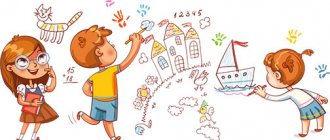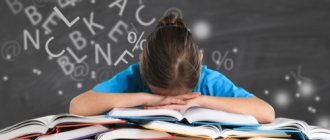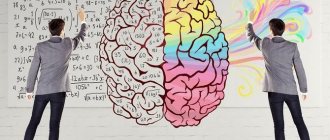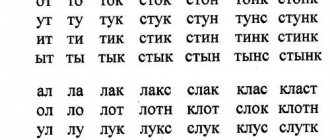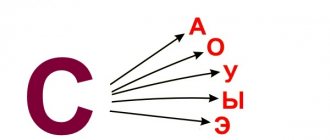Application of elements of bioenergoplastics in the work of a speech therapist teacher
Bioenergoplasty as a method in the correction of speech disorders.
"A child's mind is at his fingertips"
. V.A. Sukhomlinsky
Speech is the result of the coordinated activity of many areas of the brain. It is known that the preschool period is significant in the development and formation of a child’s speech. Currently, there is a significant increase in the number of children with speech disorders. In this regard, one of the urgent tasks in my work as a speech therapist is to increase the efficiency of the process of correcting speech disorders through the use of modern health technologies and techniques.
A traditional form of work to correct speech disorders, articulatory gymnastics, promotes the development and strengthening of speech muscles, which in turn helps long-term retention of articulatory postures and correct sound pronunciation. However, daily, standard exercises for the tongue reduce children's interest in classes. In other words, the increase in the number of children with speech impairments and traditional measures to eliminate them contribute little to the effectiveness of correctional work
In recent years, many authors have described methods for the development of fine motor skills in children with speech disorders (with delayed speech development - Zhukova N.S., Mastyukova E.M., Filicheva T.B., with stuttering - Belyakova L.I., Rychkova N. .A., with dysarthia - Lopatina L.V., Serebryakova N.V.). All authors note the interdependence of speech and motor activity, the stimulating role of training fine movements of the fingers.
As a speech therapist, I became interested in a new and interesting area of correctional work, such as bioenergoplasty. The term "bioenergoplasty"
consists of two words: bioenergy and plastic. According to I.V. Kuris, bioenergy is the energy that is inside a person. Plastics are smooth, liberated movements of the body and hands, which are the basis of bioenergoplasty.
Bioenergoplasty is a combination of movements of the articulatory apparatus with movements of the hand. Body movements, joint movements of the hand and the articulatory apparatus, provided they are plastic, relaxed and free, help to activate the natural distribution of bioenergy in the body. This has a beneficial effect on enhancing the intellectual activity of children, developing coordination and fine motor skills.
Elements of bioenergoplasty can also be found in systems for the development of intelligence using kinesiology methods (massage of the hands, neck, shoulders, finger motor skills, articulatory gymnastics). This is another argument in favor of the use of bioenergoplasty, since under the influence of kinesiological training, positive structural changes in the body are noted: the work of the cerebral hemispheres is synchronized, abilities develop, memory, attention, thinking, and speech improve. Strength, balance, mobility and plasticity of nervous processes are carried out at a higher level.
Bioenergoplasty optimizes the psychological basis of speech, improves the child’s motor abilities in all respects, and promotes the correction of sound pronunciation and phonemic processes. Bioenergoplasty allows you to quickly reduce and even remove the visual support - the mirror - and move on to performing exercises based on sensations. This is especially important, since in life children do not see their articulation.
Work in the bioenergoplastics system:
activates the natural distribution of bioenergy in the child’s body;
stimulates intellectual activity;
develops coordination of movements, fine and gross motor skills;
develops the articulatory apparatus;
forms emotional and mental balance, active physical state, activates mental processes.
In the correctional work of a speech therapist teacher, using bioenergoplasty, the most significant is the connection of movements of the hands with movements of the organs of the articulatory apparatus. When performing an articulation exercise, the hand shows where and in what position the tongue, lower jaw or lips are located. Such gymnastics helps to maintain the child’s interest for a long time, helps to increase the motivational readiness of children, and maintains the positive emotional mood of the speech pathologist and teacher throughout the lesson. When teaching children, the speech therapist uses various game characters, gloves, counting, music, poetry, and presentation materials.
In the specialized literature, the method of using bioenergoplasty when performing articulatory gymnastics with children is not fully disclosed.
Bioenergoplasty can become an integral part of speech therapy work, both for the development of the articulatory apparatus, speech breathing and the complex: speech and movement, as well as for emotional and mental balance and perfection. Synchronizing work on speech and fine motor skills halves the time of classes, not only without reducing, but even increasing their effectiveness.
As part of the implementation of the Federal State Educational Standard for Education, priority is given to such forms of work that allow solving the tasks of the educational program in specific forms of children's activities (play and joint activities with children).
Corrective work using elements of bioenergoplasty for children with speech impairments must begin with the study and analysis of the characteristics of the state of the child’s nervous system, according to individual capabilities. The center of the pedagogical process is the forms of subgroup and individual work with children. Exceptional importance in the pedagogical process is given to play, which allows the child to show his own activity and realize himself most fully.
There may be an opinion that the bioenergoplasty method is labor-intensive. In fact, both a teacher and a speech therapist can apply it in practice. It is important to evaluate both the emotional, developmental and health-saving benefits, as well as the organizational component of articulatory gymnastics carried out on the basis of the bioenergoplasty method. Observing children while performing articulatory gymnastics, you can notice that children’s hands are always looking for something to do, nature itself strives for entertainment, for play. The bioenergoplasty method combines elements of play and targeted corrective actions in the best possible way.
Thus, the main principle of bioenergoplasty is the conjugate work of the hands, fingers and articulatory apparatus, where hand movements imitate the movements of the speech apparatus. Correctional work using the bioenergoplastics method arouses children's interest in speech therapy classes. Each speech therapist can develop an acceptable set of exercises aimed at producing sounds of different groups using the bioenergoplastics method. Exercise sets may vary in complexity depending on the age of the children. It is also possible to use elements of bioenergoplastics as warm-ups and physical exercises in any type of activity. The proposed method can be used not only by speech therapists, but also by educators in correctional work.
An approximate complex of articulatory gymnastics,
aimed at producing whistling sounds using the Bioenergoplastika method
When performing the exercises, the child sits on a chair opposite the speech therapist. The child's arms are spread to the sides, elbows bent. Each exercise is performed for 5 - 7 seconds. After completing each exercise, the child is asked to lower his hands and relax.
Exercise for the language “Hippopotamus”
- the exercise is accompanied by squeezing and unclenching the hands;
Exercise for the tongue “Smile”
- fingers clenched into a fist;
Tongue exercise “Tube”
- fingers closed, extended forward;
Exercises “Smile”
and
“Tube”
alternate 2-3 times.
Tongue exercise “Scapula”
- the hands are relaxed and lowered;
Tongue exercise “Grooved”
- the hands take the shape of
a “boat”
(fingers are closed, slightly bent, fingertips are adjacent to each other);
Exercise for the tongue "Gorka"
- the hand takes the shape of a slide;
Exercises "Groove"
and
“Gorka”
alternate 2-3 times.
In conclusion, I would like to note that the use of the bioenergoplasty method opens up great prospects in achieving the goals of speech therapy work. It also expands the possibilities for the expression of teacher creativity.
“Hand movements are like the flapping of a wing,
Without them the flight will not take place...
I wish you happiness and goodness!
And the best is yet to come!”
Literature:
Badayan L.O. Neuropathology M., 1982
Dudiev V.P. Means for the development of fine motor skills in children with speech disorders // Defectology, -1999, -No. 4
Kiryanova R.A. Comprehensive diagnostics. St. Petersburg, 2002
Krupenchuk O.I. Teach me to speak correctly! for children 4-6 years old. St. Petersburg, 2004
Kuznetsova E.V. Tikhonova I.A. Development and correction of speech in children 5-6 years old. M., 2004
Novikovskaya O.A. Logorhythmics. St. Petersburg, 2005
Novotortseva N.A. Speech development in preschoolers. Yaroslavl, 1999
Rychkova N.A. Speech therapy rhythm. M., 2000
Savina L.P. Finger gymnastics for the development of speech in preschoolers. AST., 1999
Master class “Bioenergoplasty as an element of non-traditional speech therapy work”
Good speech is the most important condition for the comprehensive development of children. The richer and more correct a child’s speech, the easier it is for him to express his thoughts, the wider his opportunities for understanding the surrounding reality, the more meaningful and fulfilling his relationships with peers and adults.
That is why last week a master class on speech development was held at the kindergarten No. 36 on the topic: “Bioenergoplasty as an element of non-traditional speech therapy work.” Speech therapist Marina Viktorovna Nikulina shared her experience.
Speech therapists and educators from our city gathered in the hall, who are attracted by everything new in the development of speech, who decided to try themselves in an exciting activity - bioenergoplastics. And the lesson was really interesting!
First, the guests learned about a new non-traditional method in speech therapy work. After theory, we smoothly moved on to practice - creating a glove hero. After the necessary preparations, the guests began to design the character: some did this using pre-prepared material (buttons, ribbons, bows, decorative eyes), others drew their favorite heroes on their gloves using markers.
The work was in full swing, and it was very interesting to observe this process from the outside: the craftsmen, armed with tools, diligently carried out the task assigned to them. Of course, they had to replenish their speech corner with a new game, a new character.
The creative process continued for half an hour, but the result was worth it. Each teacher got his own character, unlike anyone else.
Then the teachers performed a series of articulation exercises, accompanying them with gestures of the glove hero.
The music hall of the kindergarten and our hearts were filled with energy, friendship and the joy of communication. The master class was a great success!
Author of the report: Nikulina Marina Viktorovna
teacher-speech therapist of MADOOU Kindergarten No. 36
From the editors of the online publication “Kindergartens of the Tyumen Region” All authors of reports in the “Preschool News” section, which are published under an editorial agreement with a preschool educational institution, can order a “Certificate of publication in the media” at any time. Sample: Certificate of publication in the media.pdf
Go to order form >>>
Dear Colleagues! Tell us about interesting events in your kindergartens. How to become an author >>>
Your material will participate in the regional competition “Kindergarten: Day by Day” for the best coverage of the activities of a preschool educational organization in the Internet space in the 2021/2022 academic year. Awarding on the Day of teachers and preschool education workers at the regional holiday Pedagogical Forum in the Department of Education and Science.
Share
"Bioenergoplasty"
Hand pose:
all exercises are performed first with one hand, then with the other, and finally with both hands together.
The pace of execution is slow. Gradually the pace of execution increases. Children are guided by the pace set by the adult, his counting and the pattern of hand movement.
Flashlights.
Place your palms in front of you, straightening and spreading your fingers. Clench and unclench your fingers on both hands at the same time, accompanying the movements with your mouth, opening and closing your mouth.
Boat.
Both palms are placed on the edge and connected by a “bucket”, the thumbs are pressed to the palms. “The boat floats”, at the same time the tongue slides across the lips from one corner of the lip to the other.
Steamboat.
Both palms are connected by a “bucket”, all fingers, except the thumbs, are directed away from you, and the thumbs are raised up and connected - this is a “pipe”, at the same time moving your hands to the sides, as if swaying slightly, clicking your lips.
River and fish.
Straightened palms pressed against each other. Fingers pointing to the side
"Push". Turn your closed palms to the right and left, imitating the movement of a fish’s tail, while the tongue rests on one or the other cheek.
Trees.
Place your hands in front of you, palms facing you. The fingers are spread apart and tense. The tongue rests on the upper lip. After completing the exercise, shake your hands and wag your tongue.
Roots.
Palms down. The fingers are spread apart and tense. Hold your hands and tongue resting on your lower lip in this position for a count of five to ten. After the exercise, relax your hands, shake your hands and wag your tongue.
The bird drinks some water.
Putting your fingers together in a pinch is a beak. Without lifting your elbow from the table,
touch the table with your beak. Next - imitate the movements of the bird: grab the “water”, raise the “head”, click your beak while making your lips a tube and move them.
The bird is flying.
Place your hands in front of you (palms facing you). Interlace your thumbs – this is the “head” of the bird. The remaining fingers are “wings”. Wave them, “wings” up, stick out your tongue, “wings” down, remove your tongue.
Flower.
The palms are raised up, the fingers form a “bud”, the bases of the hands are pressed against each other. The flower is blooming: we simultaneously spread our fingers to the sides, imitating the sound -a- with our mouth, without pronouncing it, then bring our fingers together, imitating the sound -u- with our mouth, without pronouncing it.
Kitty.
Clench your two palms into fists at the same time and place them on the table, then simultaneously straighten and press your palms to the table. The cat gets angry when her fists are clenched; when her palms are pressed to the table, the cat smiles.
Gates.
Place your palms on the edge, fingers facing each other - the “gate” is closed, the mouth is closed. The gate opens - the mouth opens wide.
